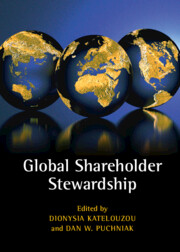Book contents
- Endorsements
- Global Shareholder Stewardship
- Global Shareholder Stewardship
- Copyright page
- Dedication
- Contents
- Figures
- Tables
- Contributors
- Foreword
- Acknowledgements
- Abbreviations
- Part I Foundations
- Part II Jurisdictions
- 4 Shareholder Stewardship in the Netherlands
- 5 Capitalist Stakeholders
- 6 Institutional Investor Stewardship in Italian Corporate Governance
- 7 The Danish Stewardship Code
- 8 Stewardship Norwegian-Style
- 9 Stewardship and Shareholder Engagement in Germany
- 10 The Japanese Stewardship Code
- 11 Korea’s Stewardship Code and the Rise of Shareholder Activism
- 12 The Assessment of Taiwan’s Shareholder Stewardship Codes
- 13 Stewardship in the Hong Kong International Financial Centre
- 14 Singapore’s Embrace of Shareholder Stewardship
- 15 Institutional Investor Stewardship in Malaysia
- 16 The Thai Institutional Investors Stewardship Code and Its Implementation
- 17 Shareholder Stewardship in India
- 18 Institutional Investors in China
- 19 Stewardship and Collective Action
- 20 Stewardship Principles in Canada
- 21 The Uncertain Stewardship Potential of Index Funds
- 22 Encouraging Sustainable Investment in South Africa
- 23 Stewardship in Kenya
- 24 The Brazilian Stewardship Framework
- Part III Comparisons
- Index
8 - Stewardship Norwegian-Style
Fragmented and State-Dominated (but Not without Potential?)
from Part II - Jurisdictions
Published online by Cambridge University Press: 28 April 2022
- Endorsements
- Global Shareholder Stewardship
- Global Shareholder Stewardship
- Copyright page
- Dedication
- Contents
- Figures
- Tables
- Contributors
- Foreword
- Acknowledgements
- Abbreviations
- Part I Foundations
- Part II Jurisdictions
- 4 Shareholder Stewardship in the Netherlands
- 5 Capitalist Stakeholders
- 6 Institutional Investor Stewardship in Italian Corporate Governance
- 7 The Danish Stewardship Code
- 8 Stewardship Norwegian-Style
- 9 Stewardship and Shareholder Engagement in Germany
- 10 The Japanese Stewardship Code
- 11 Korea’s Stewardship Code and the Rise of Shareholder Activism
- 12 The Assessment of Taiwan’s Shareholder Stewardship Codes
- 13 Stewardship in the Hong Kong International Financial Centre
- 14 Singapore’s Embrace of Shareholder Stewardship
- 15 Institutional Investor Stewardship in Malaysia
- 16 The Thai Institutional Investors Stewardship Code and Its Implementation
- 17 Shareholder Stewardship in India
- 18 Institutional Investors in China
- 19 Stewardship and Collective Action
- 20 Stewardship Principles in Canada
- 21 The Uncertain Stewardship Potential of Index Funds
- 22 Encouraging Sustainable Investment in South Africa
- 23 Stewardship in Kenya
- 24 The Brazilian Stewardship Framework
- Part III Comparisons
- Index
Summary
The nature of stewardship varies based on shareholder structures. In the Nordic region (similar to many Asian jurisdictions), the role of states, sovereign holding companies and wealth funds, other public market actors such as public pension funds, families, family-controlled investment companies and family-based foundations is significant compared to (other) national and international institutional investors. In this chapter, we discuss the peculiarities of Nordic stewardship as a backdrop for our analysis of Norwegian stewardship, which is dominated by the state and the municipalities, but also to some extent by private investors. In Part II we discuss the Nordic stewardship in light of international stewardship discussion, before concentrating on Norway and the current regulatory framework of stewardship there in Part III, reflecting on the Norwegian choices concerning stewardship in light of global challenges. Part IV reflectss on why a stewardship code is not needed in Norway. What Norway does need, is a clear and mandatory regulation to ensure that Norwegian business and finance contribute to the transition to sustainability. A stewardship code would not be a sufficiently strong measure. Conversely, it could hold Norwegian business and finance back in the face of the rapid developments on EU and international level.
Keywords
- Type
- Chapter
- Information
- Global Shareholder Stewardship , pp. 174 - 191Publisher: Cambridge University PressPrint publication year: 2022
- 1
- Cited by

